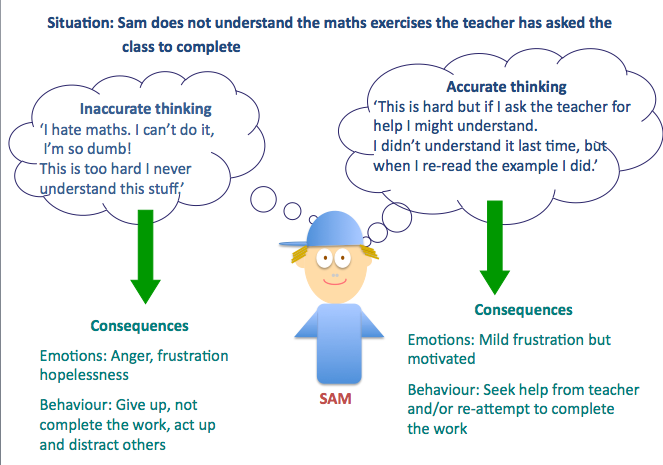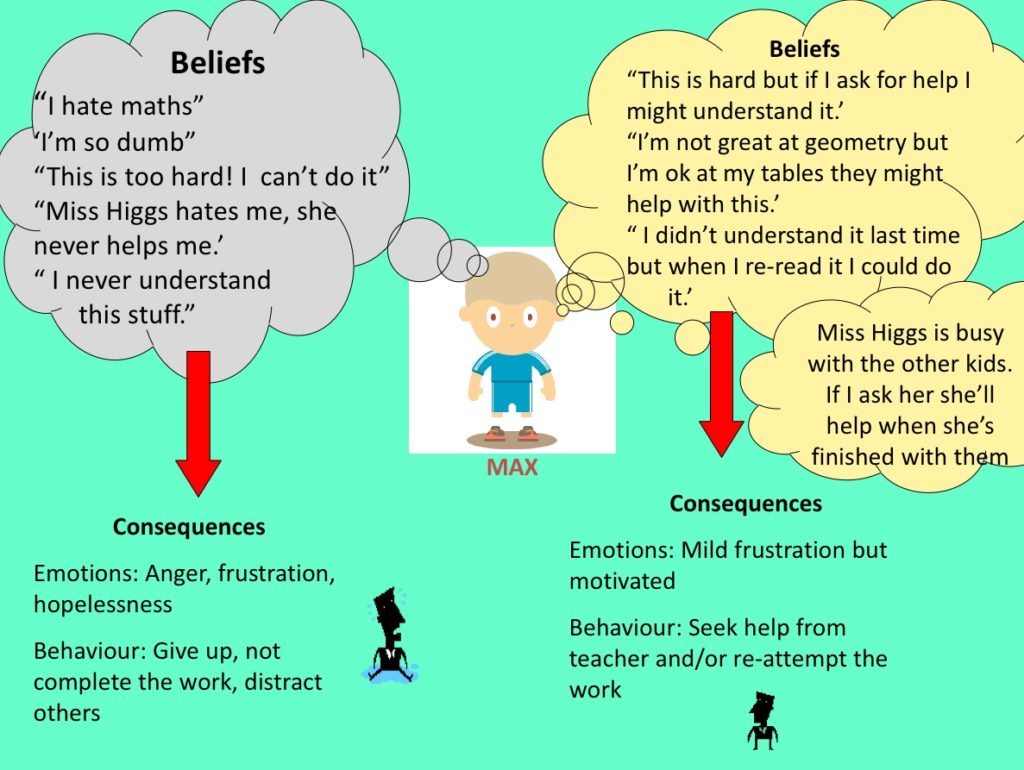
Resilience: What you think determines the way you feel
July 19, 2012
Many children and adults mistakenly believe that what happens to them (the situation) determines how they feel. For example, their train is late and they feel angry or they have to give a presentation to a big group of people and they feel scared. In the 1960s Psychiatrist Aaron Beck theorised that this is not the case instead he put forward that:
It is not the situation but what you think about the situation that determines how you feel.
For example, if you miss the train and think, ‘Oh great now I’m going to be late, my day is ruined’ you will feel frustrated and angry, if however, you think, ‘Oh well, another one will be along in 5 or 10 minutes, I might still make it on time’ you will feel okay. See another example below.
The way people tend to think about situations in their life has implications for their health and success. Individuals who tend to think negatively about situations do less well in terms of academic, social, employment and sporting outcomes and often have more physical and mental health problems than people who tend to think positively.

This does not mean you need to change your thinking to being positive all of the time. This can also be unhelpful. We do however need to teach children to think accurately about a situation. When we think negatively about a situation, for example, ‘I always spell poorly, I’m stupid’, we are not thinking accurately. We are not ‘stupid’. We might be having trouble today remembering how to spell all of our spelling words, but we are not ‘stupid’, we may just need more practice spelling the word.
Teaching children that what they think determines the way they feel, AND that with practicethey can change how they think about a situation, to see it more accurately is one of the most important lessons in building resilience. It important as it provides children with some control over situations in which they feel powerless (for example when their parents fight, or a child calls them names). Teaching children that they can learn to control they way they think about a situation, which can in turn help them adjust how they feel and act, can be very powerful.
Teachers can help children to think more accurately. Some strategies include:
1. Teach them to recognise their own thoughts. Talk to children about their thoughts or ‘self talk’ that comments on what they and others are doing. If a child has trouble identifying the thoughts, have them look into a mirror and ‘listen’ to what they are saying in their mind as they think about themselves or others.
2. Teach them that it is not what happens, but what you think about it that determines the way you feel. Provide examples to illustrate the point, for example, thinking to yourself ‘I am ‘dumb’ at maths’, can be changed to ‘I’m still learning to do this part of maths’ or ‘I find fractions tricky but am good at geometry, I will ask my teacher for more help with fractions’.
3. Teach children to be detectives and look for clues. Ask, ‘Is the thought that is making you feel upset really true?’ Ask them to state the evidence? What are the clues telling you?For example, a grade 5 girl may think, ‘Anna picked Indi to be her partner today, she must not like me anymore.’
The steps above can be taught to the whole class, or used by you when talking with a student who is upset, angry, sad or giving up easily.
Teachers can also model this each day in the classroom. For example, when making a mistake on the board you can say, ‘Oh I’m silly. No, what I meant is … sometimes I make mistakes, but I’m learning and trying hard to spell everything right. Next time I’ll probably get it right first try.’
The Beyond Blue program SenseAbility has some great videos on You Tube that teachers can use to demonstrate this concept further. Click here to view them.